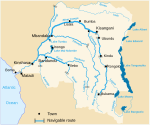Aruwimi River: Difference between revisions
mNo edit summary |
add coords & GEOnet link, c/e |
||
| Line 1: | Line 1: | ||
{{Unreferenced|date=December 2009}} |
|||
[[File:In Darkest Africa ascending Aruwimi River.jpg|right|250px|thumb|An engraving of Stanley's expedition ascending the Aruwimi, from his book ''In Darkest Africa'', 1890]] |
[[File:In Darkest Africa ascending Aruwimi River.jpg|right|250px|thumb|An engraving of Stanley's expedition ascending the Aruwimi, from his book ''In Darkest Africa'', 1890]] |
||
The '''Aruwimi River''' is a [[tributary]] of the [[Congo River]], located to the north and east of the Congo. |
The '''Aruwimi River''' is a [[tributary]] of the [[Congo River]], located to the north and east of the Congo. |
||
The Aruwimi begins as the '''Ituri River''', which arises in the savannas north of the Kibale River watershed. It then runs generally south southwest until it is joined by the Shari River which flows by Bunia. The Ituri then turns west, through the fabled [[Ituri Forest]], becoming the Aruwimi where the Nepoko (or Nepoki) River joins it, at the town of [[Bomili]]. The river continues westward, joining the Congo at [[Basoko]] |
The Aruwimi begins as the '''Ituri River''', which arises near [[Lake Albert (Africa)|Lake Albert]],<ref name=bossche>{{cite book |last= Bossche |first= J.P. vanden |coauthors= G. M. Bernacsek |title= Source Book for the Inland Fishery Resources of Africa, Volume 1 |year= 1990 |publisher= Food and Agriculture Organization of the United Nations |isbn= 9789251029831 |url= http://books.google.com/books?id=WLZRxM9vfXoC&pg=PA338 |page= 338}}</ref> in the savannas north of the Kibale River watershed. It then runs generally south southwest until it is joined by the Shari River which flows by Bunia. The Ituri then turns west, through the fabled [[Ituri Forest]], becoming the Aruwimi where the Nepoko (or Nepoki) River joins it, at the town of [[Bomili]]. The river continues westward, joining the Congo at [[Basoko]]. The length of the Aruwimi–Ituri is about {{convert|1030|km|mi}}, with the Ituri being about {{convert|650|km|mi}} and the Aruwimi about {{convert|380|km|mi}}.<ref name=bossche/> The Aruwimi is about {{convert|1.5|km|mi}} wide where it joins the Congo. |
||
The watershed of the Ituri/Aruwimi is almost entirely dense forest, with just a handful of villages along its course, and crossed by roads in about four places. The [[Kango language]] ([[SIL code]] KZY) is spoken by several thousand villagers just south of Avakubi, and upper reaches of the Ituri are inhabited by the [[Mbuti]] ([[Pygmy|Pygmies]]). |
The watershed of the Ituri/Aruwimi is almost entirely dense forest, with just a handful of villages along its course, and crossed by roads in about four places. The [[Kango language]] ([[SIL code]] KZY) is spoken by several thousand villagers just south of Avakubi, and upper reaches of the Ituri are inhabited by the [[Mbuti]] ([[Pygmy|Pygmies]]). |
||
| Line 10: | Line 9: | ||
Tributaries: |
Tributaries: |
||
* Nepoko |
* Nepoko |
||
* Lenda |
* Lenda |
||
Settlements: |
Settlements: |
||
* [[Bomaneh]] |
* [[Bomaneh]] |
||
* [[Mongandjo]] |
* [[Mongandjo]] |
||
| Line 26: | Line 23: | ||
* [[Teturi]] |
* [[Teturi]] |
||
* [[Bunia]] |
* [[Bunia]] |
||
==References== |
|||
{{Reflist}} |
|||
==External links== |
|||
*{{GEOnet2|32FA87A4371C3774E0440003BA962ED3|Aruwimi}} |
|||
{{Rivers of the Democratic Republic of the Congo}} |
{{Rivers of the Democratic Republic of the Congo}} |
||
{{coord|1|13|N|23|36|E|display=title}} |
|||
{{Coord missing|Democratic Republic of the Congo}} |
|||
[[Category:Rivers of the Democratic Republic of the Congo]] |
[[Category:Rivers of the Democratic Republic of the Congo]] |
||
Revision as of 08:46, 9 August 2010

The Aruwimi River is a tributary of the Congo River, located to the north and east of the Congo.
The Aruwimi begins as the Ituri River, which arises near Lake Albert,[1] in the savannas north of the Kibale River watershed. It then runs generally south southwest until it is joined by the Shari River which flows by Bunia. The Ituri then turns west, through the fabled Ituri Forest, becoming the Aruwimi where the Nepoko (or Nepoki) River joins it, at the town of Bomili. The river continues westward, joining the Congo at Basoko. The length of the Aruwimi–Ituri is about 1,030 kilometres (640 mi), with the Ituri being about 650 kilometres (400 mi) and the Aruwimi about 380 kilometres (240 mi).[1] The Aruwimi is about 1.5 kilometres (0.93 mi) wide where it joins the Congo.
The watershed of the Ituri/Aruwimi is almost entirely dense forest, with just a handful of villages along its course, and crossed by roads in about four places. The Kango language (SIL code KZY) is spoken by several thousand villagers just south of Avakubi, and upper reaches of the Ituri are inhabited by the Mbuti (Pygmies).
The Aruwimi was explored by Henry Morton Stanley during his 1887 expedition to "rescue" Emin Pasha. The cataracts above Yambuya made it impossible to use the river for navigation, and the expedition had to go by land, with tremendous difficulty.
Tributaries:
- Nepoko
- Lenda
Settlements:
References
- ^ a b Bossche, J.P. vanden (1990). Source Book for the Inland Fishery Resources of Africa, Volume 1. Food and Agriculture Organization of the United Nations. p. 338. ISBN 9789251029831.
{{cite book}}: Unknown parameter|coauthors=ignored (|author=suggested) (help)

